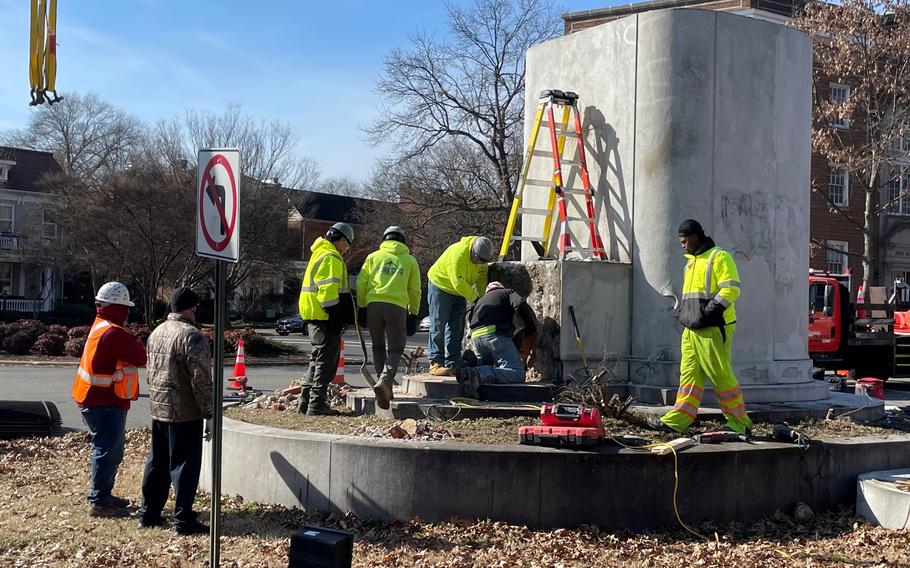
Workers dismantle the pedestal of the Matthew Fontaine Maury statue on Monument Avenue in Richmond, Va., on Tuesday. The city is taking down the remnants of Confederate memorials for the next few weeks. (Gregory S. Schneider/Washington Post)
RICHMOND, Va. - The stone pedestals left behind when this city removed its statues glorifying the Confederacy are finally beginning to come down, too, heading into storage after meticulous documentation.
It's no small task. The City Council has agreed to spend more than $1.5 million to haul away thousands of pounds of ornamental granite over the next few weeks. All of it will be preserved and put under the purview of Richmond's Black History Museum, which will work with the Valentine museum to find new uses for the materials.
Work began Tuesday on dismantling the stone base that once held a statue of maritime hero Matthew Fontaine Maury, who had a global reputation as the "Pathfinder of the Seas" but chucked his U.S. Navy commission to join the Confederacy during the Civil War.
Workers from Team Henry, the Black-owned contractor that has overseen the job of removing Richmond's Confederate monuments, lifted the 8,000-pound capstone and hoisted it onto a flatbed truck. Carvings of fish, bats and birds decorated the gray granite of the pedestal. The statue was put in place in 1929 as the last of the series of Confederate memorials on Richmond's grand Monument Avenue.
The crew used a small jackhammer to get into the base of the pedestal, then decided to pause the job just after midday because it was clear the stones holding up either side were too big for the crane on hand. A new rig was due Wednesday to hoist each 30,000-pound block.
Work will then move several blocks east on Monument to the pedestal that once supported a figure of Gen. J.E.B. Stuart, said Jeannie Welliver, of Richmond's special capital projects office. Still to go: pedestals from statues honoring Gen. Thomas J. "Stonewall" Jackson, Confederate President Jefferson Davis, and Confederate soldiers and sailors, as well as the stone base of a Confederate cannon.
One job promises to be trickier than the others: The statue of Confederate Gen. A.P. Hill still stands in the middle of a busy intersection because his remains are buried beneath it - standing up, supposedly. City officials are negotiating with the general's descendants in the Culpeper area to relocate his remains to a cemetery.
The city will landscape many of the pedestal sites until community efforts, led by the museums, come up with a long-term plan for what to do with the properties. The fates of the Hill and Jackson sites, however, are already determined: The two intersections where they have stood like roadblocks will simply be paved over, to the relief of motorists and traffic cops alike.
In total, the city will sock away some 1,280 stones, according to Welliver. More than 500 of the stones came from the granddaddy pedestal of them all, the 40-foot tower that once supported the figure of Gen. Robert E. Lee. The state of Virginia took down that statue and pedestal last year and deeded the property to the city.
"We are taking such care of the pedestal pieces," Welliver said. Each pedestal has been digitally scanned and modeled in 3D, she said. All the stones are catalogued as they are removed and marked with metal tags so they can be reassembled.
"Like instructions for Ikea furniture," said Paul DiPasquale, a local sculptor who is advising the city on care for the artifacts.
And there might be more than stones. The Maury, Jackson and Davis monuments are all likely to contain time capsules, said local historian Dale Brumfield, who has researched all the statues.
Brumfield's work led state officials to search the Lee statue's base for a time capsule. They eventually found two: one official, the other a personal tribute left by two of the men who designed the Lee site. The time capsules contained books, papers and memorabilia related to the Civil War and Richmond at the end of the 19th century. The materials are still being studied by state historians.
There was no evidence of a time capsule at the Maury site Tuesday. But DiPasquale said that given the ornate nature of the monument, he would not be surprised to find that the artist who created it also installed a memento underneath.
DiPasquale has some experience with the topic. He created the statue of tennis legend Arthur Ashe that the city installed a few blocks farther west on Monument Avenue in the 1990s.
"There's a time capsule under the Ashe monument," DiPasquale said, "because I put it there."